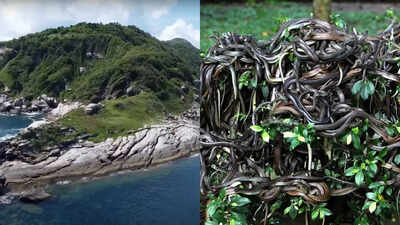ARTICLE AD BOX

Just 93 miles off the coast of São Paulo, Brazil, lies Ilha da Queimada Grande, more famously known as Snake Island. Despite its stunning tropical scenery and surrounding Atlantic waters, the island is considered one of the deadliest places on Earth.
It is home to thousands of venomous snakes, most notably the golden lancehead viper, whose bite can be fatal within an hour. Human access is strictly prohibited by the Brazilian government to protect both people and the critically endangered snake population. Scientists can only visit with special permits under strict safety protocols.
Snake Island is home to the world’s deadliest snakes
Snake Island is the only natural habitat of the golden lancehead viper (Bothrops insularis), a species whose venom is extremely potent.
Its bite can cause internal bleeding, kidney failure, tissue necrosis, and hemorrhaging in the brain. This venom evolved to act quickly, allowing the snake to immobilize prey such as birds in seconds. Researchers have noted that the golden lancehead’s venom is up to five times stronger than that of similar mainland species, an adaptation resulting from evolutionary isolation and a diet mainly consisting of birds.
The island itself is just 106 acres, yet snake density is astonishing. Estimates suggest there may be nearly one snake per square meter, making every inch of jungle and rock potentially dangerous. This high density means that even a small misstep could result in a fatal encounter. The snakes’ dominance also creates a unique ecosystem, where they act as top predators, with no large animals threatening their reign.

Human restrictions and safety concerns
Snake Island is inhospitable to humans. There are no freshwater sources, hospitals, or emergency services, and any snake bite could be fatal within hours without immediate treatment.
The Brazilian Navy has enforced a strict ban on civilian access, permitting only authorized scientists to visit under tight safety regulations. Researchers must carry medical supplies, wear protective gear, and always work in teams to mitigate the high risk of injury.Legends and historical accounts add to the island’s terrifying reputation. Stories include lighthouse keepers and their families who reportedly died from snake bites, as well as fishermen who accidentally landed on the island and were never seen again.
While these tales are partly folklore, they reflect the very real dangers posed by an environment dominated by thousands of venomous snakes.

Image: Latin American Post
Endangered species and ecological significance
Despite their lethality, golden lanceheads are critically endangered. Their rarity and unique venom have made them targets for illegal wildlife trafficking, with black market values reportedly reaching tens of thousands of dollars per snake. Conservation efforts by Brazilian authorities aim to protect the species while preserving the delicate ecosystem of the island.
By controlling human access, the snakes are able to thrive in their natural habitat without interference.Snake Island’s ecosystem also plays a crucial role in the life cycle of migratory birds. The vipers feed primarily on birds that land to rest on the island, creating a predator-prey dynamic that has existed for centuries. The island remains a place of deadly beauty—lush vegetation, rocky cliffs, and pristine ocean views—yet human survival is nearly impossible. Its isolation and danger make it one of the world’s most mysterious and forbidden natural wonders.



.png)
.png)
.png)
















 1 day ago
4
1 day ago
4









 English (US) ·
English (US) ·